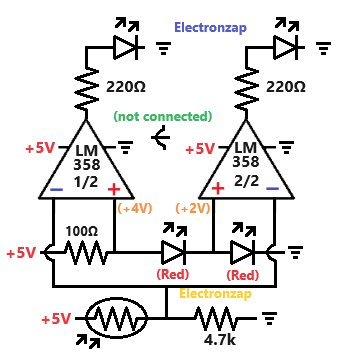Table of Contents
Demonstration circuit of a somewhat practical way that you could use the 2V and 4V of two series red LEDs as reference voltages. There’s better ways to make reference voltages, but almost everyone has red indicator LEDs, so it’s still a nice circuit to build and/or study while learning electronics.

- Dark = Both output LEDs on.
- Medium light = One output LED on.
- Bright light = Both LEDs off.
- Reference LEDs will always be on.
- LM358 is a dual op amp (two op amps in one IC)
- 2 series red (2V forward voltage) LEDs with 10mA of current going through them thanks to a 5V supply and 100Ω resistor.
- LED closer to ground will build up 2V at its Anode (in relationship to ground).
- LED further from ground will have 4V at its anode thanks to both LEDs building up 2V each for a total of 4V at its Anode (in relationship to ground).
- The 2V goes to one of their op amp’s non inverting input in order to set a reference voltage for that op amp.
- The 4V goes to the other op amp’s non inverting input in order to set a reference voltage for that op amp.
- High side LDR (Light Dependent Resistor) and low side 4.7k (four thousand seven hundred ohm) resistor for a voltage divider. The signal voltage that it provides is fed to the non inverting input of the op amp.
- Very low to no light on LDR raises its resistance, so that the output voltage is almost zero volts (at output) between it and the 4.7k resistor.
- Very bright light on LDR lowers its resistance, so that the output voltage is almost the full supply voltage of 5V between it and the 4.7k resistor.
- A middle ground of light on the LDR based voltage divider will provide a middle ground voltage based on how much light is falling on it in relationship to those extremes.
- That means that both of the op amps are wired as inverting comparators. Higher input equals low output. Lower input voltage equals high output.
- Higher signal voltage (from LDR divider) than the reference voltage (either 2V or 4V from the corresponding LED) of the particular op amp makes the output of that op amp low.
- Higher signal voltage (from LDR divider) than the reference voltage (either 2V or 4V from the corresponding LED) of the particular op amp makes the output of that op amp low.
Good pages to check out next:
To support this site, check out the following links:
- Check out my YouTube videos! https://www.youtube.com/c/Electronzap/videos
- Products I used in my videos or otherwise think look like a good buy. As an Amazon associate, I earn from qualifying purchases. My Amazon affiliate page showing products I think look good
- Information on this site is not guaranteed to be accurate. Always consult the manufacturer info/datasheet of parts you use. Research the proper safety precautions for everything you do.
- Electronzap is a participant in the Amazon Services LLC Associates Program, an affiliate advertising program designed to provide a means for sites to earn advertising fees by advertising and linking to amazon.com.